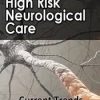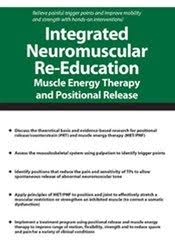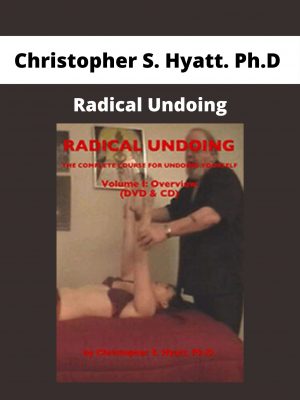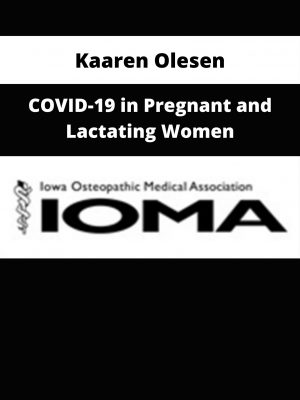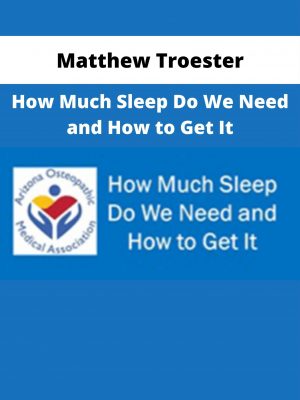Theresa A. Schmidt – Integrated Neuromuscular Re-Education, Muscle Energy Therapy and Positional Release
$200 Original price was: $200.$75Current price is: $75.
Shopping Instructions:
- DISCOUNT 15% : SHOP15
- Product Delivery: Within 1 – 12 hours after purchase.
Integrated Neuromuscular Re-Education is an introductory hands-on approach to correction of somatic dysfunction using muscle energy/PNF and counterstrain/positional release.
Theresa A. Schmidt – Integrated Neuromuscular Re-Education, Muscle Energy Therapy and Positional Release
Silence the Pain! Restore Mobility and Strength!
Integrated Neuromuscular Re-Education is an introductory hands-on approach to correction of somatic dysfunction using muscle energy/PNF and counterstrain/positional release.
The goals of INMR are to restore normal soft tissue tone and elasticity, relieve pain, improve strength and optimize performance. Identification and treatment of abnormal neuromuscular tension, painful trigger points, motion restriction and strength deficit is the focus of this recording. INMR approach is a synthesis of active and passive approaches to facilitate positive changes in the structure and function of the myofascial and neuromuscular systems.
Techniques may be immediately applied in a variety of clinical situations. A review of the current evidence-based literature will illustrate the efficacy of these interventions. This recording includes lecture, discussion and emphasis on hands-on lab practice. A must-take course for manual therapists!
- Investigate the theoretical basis and evidence-based research for positional release/counterstrain (PRT) and muscle energy therapy (MET/PNF)
- Evaluate basic neuromuscular reflexes, the function of the muscle spindle, Golgi tendon organs and proprioceptors and their effect on muscle tone and function
- Assess the musculoskeletal system using palpation to identify indicator trigger points (TPs)
- Utilize positions that reduce the pain and sensitivity of TPs to allow spontaneous release of abnormal neuromuscular tone
- Apply principles of MET/PNF to position a joint to effectively stretch a muscular restriction or strengthen an inhibited muscle (to correct a somatic dysfunction)
- Implement a treatment program using positional release and muscle energy therapy to improve range of motion, flexibility, strength, and to reduce spasm and pain for a variety of clinical conditions
NEUROPHYSIOLOGICAL BASIS OF MUSCLE TONE, TENSION AND SPASM
- Muscle spindle
- GTO reflexes
- Normal/abnormal tension patterns
JONES’ THEORY OF STRAIN/COUNTERSTRAIN AND POSITIONAL RELEASE
- Definition
- Rules
SCANNING ASSESSMENT FOR TENDER TRIGGER POINTS
- Palpable nodules, taut bands, referred pain
- Diagnostic indicators of biomechanical dysfunction
POSITIONAL RELEASE TECHNIQUE DEMONSTRATION AND LAB
- Position of comfort, pain scale and palpation
- Indications/contraindications
- Outcomes
Would you like to receive Theresa A. Schmidt – Integrated Neuromuscular Re-Education, Muscle Energy Therapy and Positional Release ?
THEORETICAL BASIS OF MUSCLE ENERGY THERAPY/PROPRIOCEPTIVE NEUROMUSCULAR FACILITATION
- Definition
- Principles
- Applications
MUSCLE ENERGY THERAPY FOR THE EXTREMITIES: DEMONSTRATION AND LAB
- Extremities demonstration
- Correction of somatic dysfunction
MUSCLE ENERGY THERAPY FOR THE SPINE AND PELVIS: DEMONSTRATION AND LAB
- Contraction types, multi-angle stretches
- Facilitation techniques
- Spine and pelvis demonstration
INTEGRATION OF TECHNIQUES INTO A TREATMENT PROGRAM
- Clinical problem solving with discussion
Related products
HEALTH & MEDICAL
HEALTH & MEDICAL
Bernadette Giorgi – Attitude Ballet & Pilates Fusion – Just B Method
HEALTH & MEDICAL
HEALTH & MEDICAL
Dr. J.E. Williams & Kevin Gianni – How to Read Your Blood Tests
HEALTH & MEDICAL
HEALTH & MEDICAL
Matthew Troester – How Much Sleep Do We Need and How to Get It
HEALTH & MEDICAL


